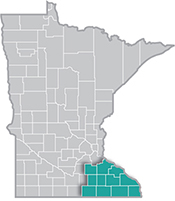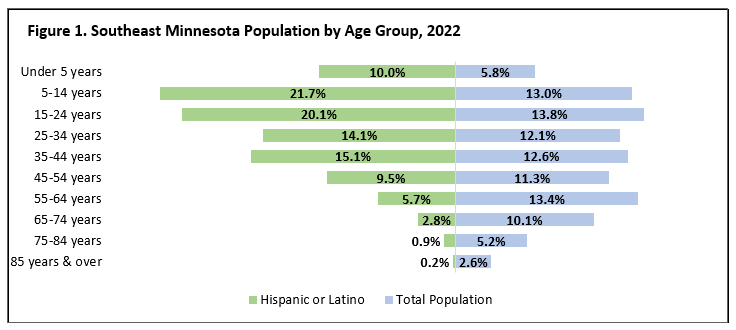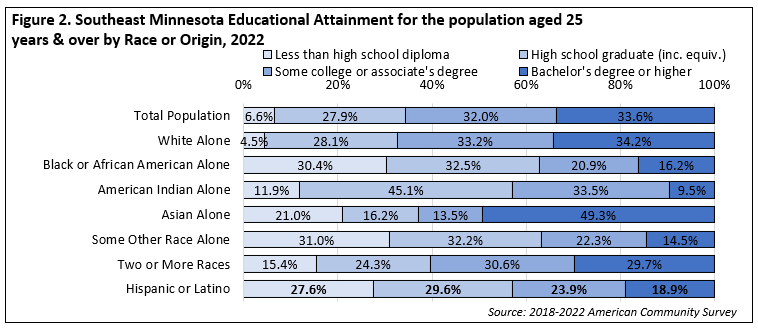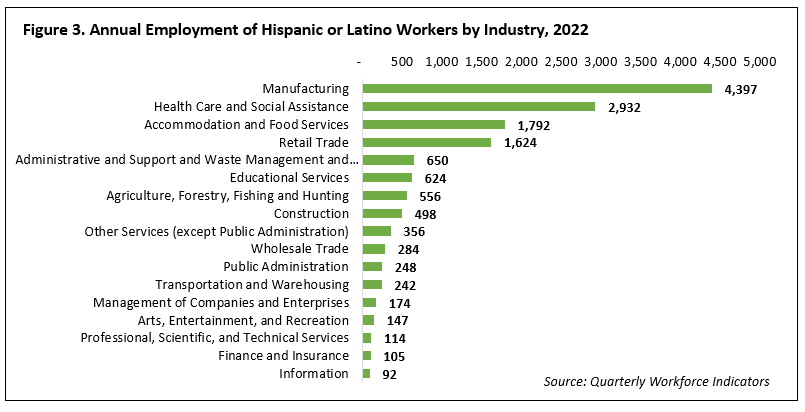 Southeast Minnesota is a health care and agricultural powerhouse. The region is home to the renowned Mayo Clinic and some of the world's most recognized food companies and brands.
Southeast Minnesota is a health care and agricultural powerhouse. The region is home to the renowned Mayo Clinic and some of the world's most recognized food companies and brands.
Advanced manufacturing is especially strong here, with machinery, chemicals, and electronics among the top products.
Want the freshest data delivered by email? Subscribe to our regional newsletters.
4/23/2024 9:00:00 AM
Amanda O'Connell
In 2022, the 11-county Southeast Region reported a total population of 517,713 people, of which 31,678 individuals, or 6.1%, identified as Hispanic or Latino. This demographic has seen a significant increase, growing by 33.2% since 2011, which translates to a gain of 7,896 additional people. The Hispanic and Latino community is increasingly becoming a crucial part of the demographic makeup and workforce in Southeast Minnesota.
Within the region, Mower County, with 12.6%, Freeborn County, with 10.6%, and Rice County, with 8.7%, have the highest percentages of Hispanic or Latino residents. In contrast, the counties with the smallest Hispanic or Latino populations are Houston County at 1.4%, Fillmore County at 1.9%, and both Wabasha and Winona counties at 3.2%.
There are several subgroups within the Hispanic or Latino population, each with distinct cultural traits and experiences. These include Mexican, Puerto Rican, Cuban, and other people with Hispanic or Latino origins. In Southeast Minnesota, the largest subgroup is Mexican, comprising 72.9% of the Hispanic or Latino population, followed by Other Hispanic or Latino at 20.7%. Additionally, 3.8% of the Hispanic or Latino population identify as Puerto Rican, while 2.7% identify as Cuban. From 2011 to 2022, the subgroup with the largest percentage increase in population was those of Cuban descent (Table 1).
| Table 1. People of Hispanic or Latino Origin in Southeast Minnesota, 2022 | ||||||
|---|---|---|---|---|---|---|
| County | Total population | Hispanic or Latino | Mexican | Puerto Rican | Cuban | Other Hispanic or Latino |
| Dodge | 20,893 | 5.1% | 78.4% | 1.3% | 2.2% | 18.1% |
| Fillmore | 21,251 | 1.9% | 75.1% | 0.0% | 0.2% | 24.6% |
| Freeborn | 30,857 | 10.6% | 82.0% | 1.6% | 3.5% | 12.9% |
| Goodhue | 47,697 | 3.6% | 62.5% | 0.1% | 5.6% | 31.8% |
| Houston | 18,826 | 1.4% | 35.2% | 5.6% | 0.0% | 59.2% |
| Mower | 40,082 | 12.6% | 82.3% | 0.9% | 6.4% | 10.4% |
| Olmsted | 162,307 | 5.3% | 61.3% | 7.4% | 2.5% | 28.8% |
| Rice | 67,152 | 8.7% | 78.7% | 1.8% | 0.5% | 19.0% |
| Steele | 37,396 | 8.3% | 86.0% | 3.0% | 0.2% | 10.8% |
| Wabasha | 21,460 | 3.2% | 44.2% | 11.4% | 3.7% | 40.8% |
| Winona | 49,792 | 3.2% | 66.0% | 9.3% | 0.0% | 24.7% |
| Southeast Minnesota | 517,713 | 6.1% | 72.9% | 3.8% | 2.7% | 20.7% |
| Change from 2011-2022 | +5.1% | +33.2% | +17.5% | +89.7% | +154.5% | +107.0% |
| Source: American Community Survey, 2018-2022 | ||||||
The Hispanic or Latino population in Southeast Minnesota has a younger age profile than the total population, whose median age is increasing. Nearly two-thirds (66%) of Hispanic or Latino individuals are under the age of 34, compared to just 44.7% of the total population. Conversely, less than 4% of the Hispanic or Latino community is aged 65 and older, compared to 18% of the total population.

The educational attainment of Hispanic or Latino individuals over 25 years differs from the overall population as well. A much higher percentage of Hispanic or Latino residents, 27.6%, have not completed high school compared to 6.6% of the total population. In contrast, just 18.9% of Hispanic or Latino adults in the region hold a bachelor's degree or higher, compared to 33.6% of the total population. These data highlight educational disparities that may affect the Hispanic or Latino community (Figure 2).

In Southeast Minnesota, individuals of Hispanic or Latino origin have a labor force participation rate of 76.2%. This is notably higher than the overall labor force participation rate of 67.4%, showcasing the strong work ethic and younger age profile within the Hispanic and Latino community. However, despite their high participation in the workforce, the unemployment rate is 6.1%, which is higher than the overall rate of 3.5%. This discrepancy displays a willingness to work despite facing greater challenges in securing employment.
According to Quarterly Workforce Indicators data, the number of jobholders identifying as Hispanic or Latino in Southeast Minnesota was 8,547 in 2011. By 2022, this figure had risen to 14,744, an increase of 6,197 workers, representing 72.5% growth. In 2022, the Manufacturing, Health Care & Social Assistance, and Accommodation & Food Services sectors were the largest employers of Hispanic or Latino workers, with a combined total of 9,121 jobholders in the Southeast region. Conversely, the industries employing the fewest Hispanic or Latino workers were Information, Finance & Insurance, and Professional, Scientific & Technical Services (Figure 3).

Overall, the Hispanic and Latino population has been steadily growing in Southeast Minnesota. Despite facing higher unemployment rates and possessing lower levels of educational attainment as a group, they have a significant presence in the labor force due to their high labor force participation rate. Their young age profile offers a valuable counterbalance to the region's aging population trend, suggesting a sustained workforce presence that will support the area's economic stability for years to come.
Contact Amanda O'Connell, Labor Market Analyst, at amanda.oconnell@state.mn.us.